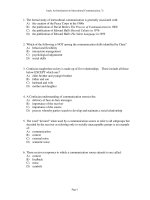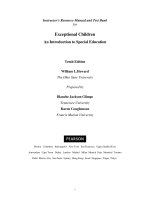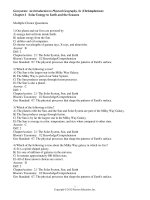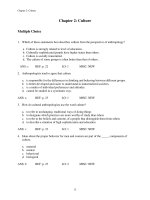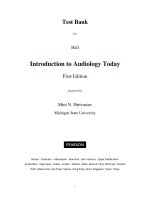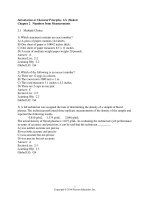Introduction to management science 12th edition taylor test bank
Bạn đang xem bản rút gọn của tài liệu. Xem và tải ngay bản đầy đủ của tài liệu tại đây (657.56 KB, 36 trang )
Introduction to Management Science, 12e (Taylor)
Chapter 2 Linear Programming: Model Formulation and Graphical Solution
1) Linear programming is a model consisting of linear relationships representing a firm's decisions given
an objective and resource constraints.
Answer: TRUE
Diff: 2
Page Ref: 32
Section Heading: Model Formulation
Keywords: model formulation
AACSB: Analytical thinking
2) The objective function always consists of either maximizing or minimizing some value.
Answer: TRUE
Diff: 2
Page Ref: 32
Section Heading: Model Formulation
Keywords: objective function
AACSB: Analytical thinking
3) The objective function is a linear relationship reflecting the objective of an operation.
Answer: TRUE
Diff: 1
Page Ref: 32
Section Heading: Model Formulation
Keywords: model formulation
AACSB: Analytical thinking
4) A constraint is a linear relationship representing a restriction on decision making.
Answer: TRUE
Diff: 1
Page Ref: 32
Section Heading: Model Formulation
Keywords: model formulation
AACSB: Analytical thinking
5) Proportionality means the slope of a constraint is proportional to the slope of the objective function.
Answer: FALSE
Diff: 2
Page Ref: 57
Section Heading: Characteristics of Linear Programming Problems
Keywords: properties of linear programming models, proportionality
AACSB: Analytical thinking
6) The terms in the objective function or constraints are additive.
Answer: TRUE
Diff: 2
Page Ref: 57
Section Heading: Characteristics of Linear Programming Problems
Keywords: properties of linear programming models, additive
AACSB: Analytical thinking
1
Copyright © 2016 Pearson Education, Inc.
7) The terms in the objective function or constraints are multiplicative.
Answer: FALSE
Diff: 2
Page Ref: 57
Section Heading: Characteristics of Linear Programming Problems
Keywords: properties of linear programming models, additive
AACSB: Analytical thinking
8) All linear programming models exhibit a set of constraints.
Answer: TRUE
Diff: 1
Page Ref: 32
Section Heading: Model Formulation
Keywords: properties of linear programming models, constraints
AACSB: Analytical thinking
9) When using the graphical method, only one of the four quadrants of an xy-axis needs to be drawn.
Answer: TRUE
Diff: 1
Page Ref: 37
Section Heading: Graphical Solutions of Linear Programming Models
Keywords: graphical linear programming
AACSB: Analytical thinking
10) Linear programming models exhibit linearity among all constraint relationships and the objective
function.
Answer: TRUE
Diff: 1
Page Ref: 57
Section Heading: Characteristics of Linear Programming Problems
Keywords: properties of linear prog models, linearity, proportionality
AACSB: Analytical thinking
11) The equation 8xy = 32 satisfies the proportionality property of linear programming.
Answer: FALSE
Diff: 2
Page Ref: 57
Section Heading: Characteristics of Linear Programming Problems
Keywords: graphical solution, proportionality
AACSB: Analytical thinking
12) Typically, finding a corner point for the feasible region involves solving a set of three simultaneous
equations.
Answer: FALSE
Diff: 2
Page Ref: 43
Section Heading: Graphical Solutions of Linear Programming Models
Keywords: graphical solution, extreme points, feasible region
AACSB: Analytical thinking
13) Objective functions in linear programs always minimize costs.
Answer: FALSE
Diff: 2
Page Ref: 32
Section Heading: Model Formulation
Keywords: properties of linear programming models, objective function
AACSB: Analytical thinking
2
Copyright © 2016 Pearson Education, Inc.
14) The feasible solution area contains infinite solutions to the linear program.
Answer: TRUE
Diff: 1
Page Ref: 39
Section Heading: Graphical Solutions of Linear Programming Models
Keywords: properties of linear programming models, feasible solution area
AACSB: Analytical thinking
15) There is exactly one optimal solution point to a linear program.
Answer: FALSE
Diff: 2
Page Ref: 55
Section Heading: Irregular Types of Linear Programming Problems
Keywords: properties of linear programming models, optimal solution pt
AACSB: Analytical thinking
16) The following equation represents a resource constraint for a maximization problem: X + Y ≥ 20.
Answer: FALSE
Diff: 2
Page Ref: 34
Section Heading: A Maximization Model Example
Keywords: properties of linear programming models, constraints
AACSB: Analytical thinking
17) The optimal solution for a graphical linear programming problem is the corner point that is the
farthest from the origin.
Answer: FALSE
Diff: 2
Page Ref: 40
Section Heading: Graphical Solutions of Linear Programming Models
Keywords: feasibility, constraints
AACSB: Analytical thinking
18) A minimization model of a linear program contains only surplus variables.
Answer: FALSE
Diff: 1
Page Ref: 53
Section Heading: A Minimization Model Example
Keywords: properties of linear programming models, surplus variables
AACSB: Analytical thinking
19) In the graphical approach, simultaneous equations may be used to solve for the optimal solution
point.
Answer: TRUE
Diff: 2
Page Ref: 43
Section Heading: Graphical Solutions of Linear Programming Models
Keywords: graphical solution
AACSB: Analytical thinking
20) Slack variables are only associated with maximization problems.
Answer: FALSE
Diff: 2
Page Ref: 45
Section Heading: Graphical Solutions of Linear Programming Models
Keywords: graphical solution, slack variables
AACSB: Analytical thinking
3
Copyright © 2016 Pearson Education, Inc.
21) Surplus variables are only associated with minimization problems.
Answer: FALSE
Diff: 2
Page Ref: 53
Section Heading: A Minimization Model Example
Keywords: graphical solution, surplus variable
AACSB: Analytical thinking
22) If the objective function is parallel to a constraint, the constraint is infeasible.
Answer: FALSE
Diff: 2
Page Ref: 55
Section Heading: Irregular Types of Linear Programming Problems
Keywords: graphical solution
AACSB: Analytical thinking
23) Multiple optimal solutions occur when constraints are parallel to each other.
Answer: FALSE
Diff: 2
Page Ref: 55
Section Heading: Irregular Types of Linear Programming Problems
Keywords: graphical solution
AACSB: Analytical thinking
24) Graphical solutions to linear programming problems have an infinite number of possible objective
function lines.
Answer: TRUE
Diff: 2
Page Ref: 40
Section Heading: Graphical Solutions of Linear Programming Models
Keywords: graphical solution, objective function line
AACSB: Analytical thinking
25) The first step in formulating a linear programming model is to define the objective function.
Answer: FALSE
Diff: 2
Page Ref: 32
Section Heading: Introduction
Keywords: linear programming problems, formulation
AACSB: Analytical thinking
26) A linear programming problem requires a choice between alternative courses of action.
Answer: TRUE
Diff: 2
Page Ref: 57
Section Heading: Characteristics of Linear Programming Problems
Keywords: linear programming problems, formulation
AACSB: Application of knowledge
27) The term continuous is synonymous with divisible in the context of linear programming.
Answer: TRUE
Diff: 2
Page Ref: 57
Section Heading: Characteristics of Linear Programming Problems
Keywords: linear programming problems, formulation
AACSB: Application of knowledge
4
Copyright © 2016 Pearson Education, Inc.
28) Linear programming problems can model decreasing marginal returns.
Answer: FALSE
Diff: 2
Page Ref: 57
Section Heading: Characteristics of Linear Programming Problems
Keywords: linear programming problems, formulation
AACSB: Application of knowledge
29) ________ are mathematical symbols representing levels of activity.
Answer: Decision variables
Diff: 1
Page Ref: 32
Section Heading: Model Formulation
Keywords: decision variables, model formulation
AACSB: Analytical thinking
30) A ________ is a linear relationship representing a restriction on decision making.
Answer: constraint
Diff: 1
Page Ref: 32
Section Heading: Model Formulation
Keywords: constraint, model formulation
AACSB: Analytical thinking
31) If at least one constraint in a linear programming model is violated, the solution is said to be ________.
Answer: infeasible
Diff: 1
Page Ref: 55
Section Heading: Irregular Types of Linear Programming Problems
Keywords: constraint, infeasible solution
AACSB: Analytical thinking
32) A graphical solution is limited to solving linear programming problems with ________ decision
variables.
Answer: two
Diff: 1
Page Ref: 36
Section Heading: Graphical Solutions of Linear Programming Models
Keywords: graphical solution
AACSB: Analytical thinking
33) The ________ solution area is an area bounded by the constraint equations.
Answer: feasible
Diff: 1
Page Ref: 39
Section Heading: Graphical Solutions of Linear Programming Models
Keywords: graphical solution
AACSB: Analytical thinking
34) Multiple optimal solutions can occur when the objective function line is ________ to a constraint line.
Answer: parallel
Diff: 2
Page Ref: 45
Section Heading: Graphical Solutions of Linear Programming Models
Keywords: graphical solution, multiple optimal solutions
AACSB: Analytical thinking
5
Copyright © 2016 Pearson Education, Inc.
35) When a maximization problem is ________, the objective function can increase indefinitely without
reaching a maximum value.
Answer: unbounded
Diff: 2
Page Ref: 56
Section Heading: Irregular Types of Linear Programming Problems
Keywords: graphical solution, unbounded problem
AACSB: Analytical thinking
36) The best feasible solution is ________.
Answer: optimal
Diff: 1
Page Ref: 41
Section Heading: Graphical Solutions of Linear Programming Models
Keywords: optimal solutions
AACSB: Analytical thinking
37) In a constraint, the ________ variable represents unused resources.
Answer: slack
Diff: 1
Page Ref: 45
Section Heading: Graphical Solutions of Linear Programming Models
Keywords: graphical solution, surplus variable
AACSB: Analytical thinking
38) ________ is the difference between the left- and right-hand sides of a greater than or equal to
constraint.
Answer: Surplus
Diff: 1
Page Ref: 53
Section Heading: A Minimization Model Example
Keywords: surplus
AACSB: Analytical thinking
39) If the objective function is parallel to a constraint, the linear program could have ________.
Answer: multiple optimal solutions
Diff: 2
Page Ref: 45
Section Heading: Graphical Solutions of Linear Programming Models
Keywords: graphical solutions, multiple optimal solutions
AACSB: Analytical thinking
40) Corner points on the boundary of the feasible solution area are called ________ points.
Answer: extreme
Diff: 1
Page Ref: 42
Section Heading: Graphical Solutions of Linear Programming Models
Keywords: feasibility, constraints
AACSB: Analytical thinking
41) ________ are at the endpoints of the constraint line segment that the objective function parallels.
Answer: Alternate optimal solutions
Diff: 3
Page Ref: 55
Section Heading: Irregular Types of Linear Programming Problems
Keywords: alternative optimal solutions, multiple optimal solutions
AACSB: Analytical thinking
6
Copyright © 2016 Pearson Education, Inc.
42) The ________ step in formulating a linear programming model is to define the decision variables.
Answer: first
Diff: 1
Page Ref: 34
Section Heading: A Maximization Model Example
Keywords: linear programming, formulation
AACSB: Analytical thinking
43) The management scientist constructed a linear program to help the alchemist maximize his gold
production process. The computer model chugged away for a few minutes and returned an answer of
infinite profit., which is what might be expected from a(n) ________ problem.
Answer: unbounded
Diff: 1
Page Ref: 56
Section Heading: Irregular Types of Linear Programming Problems
Keywords: unbounded
AACSB: Analytical thinking
44) The ________ property of linear programming models indicates that the rate of change, or slope, of
the objective function or a constraint is constant.
Answer: proportionality or linearity
Diff: 2
Page Ref: 57
Section Heading: Characteristics of Linear Programming Problems
Keywords: properties of linear programming models, certainty
AACSB: Analytical thinking
45) The objective function 3x + 2y + 4xy violates the assumption of ________.
Answer: proportionality
Diff: 2
Page Ref: 57
Section Heading: Characteristics of Linear Programming Problems
Keywords: linear programming properties
AACSB: Application of knowledge
46) Mildred is attempting to prepare an optimal quantity of macaroni and cheese for the potluck supper
this Sunday. The instructions indicate that one cup of water is needed for each box she needs to prepare.
She sleeps well on Saturday night, secure in her knowledge that she knows the precise amount of water
she will need the next day. This knowledge illustrates the assumption of ________.
Answer: certainty
Diff: 2
Page Ref: 57
Section Heading: Characteristics of Linear Programming Problems
Keywords: linear programming properties
AACSB: Application of knowledge
47) Tim! airlines procurement division works with their linear programming algorithm to secure
contracts for gasoline for the coming year. After twenty minutes of thinking, the computer suggests that
they secure 425.8125 contracts with their suppliers. This value illustrates the assumption of ________ in
linear programming models.
Answer: divisibility or continuous
Diff: 2
Page Ref: 57
Section Heading: Characteristics of Linear Programming Problems
Keywords: linear programming properties
AACSB: Application of knowledge
7
Copyright © 2016 Pearson Education, Inc.
48) Solve the following graphically:
Max z =
3x1 + 4x2
s.t.
x1 + 2x2 ≤ 16
2x1 + 3x2 ≤ 18
x1 ≥ 2
x2 ≤ 10
x1, x2 ≥ 0
What are the optimal values of x1, x2, and z?
Answer: x1 = 9, x2 = 0, z = 27
Diff: 3
Page Ref: 37-41
Section Heading: Graphical Solutions of Linear Programming Models
Keywords: graphical solution, simultaneous solution
AACSB: Analytical thinking
8
Copyright © 2016 Pearson Education, Inc.
49) A novice business analyst develops the following model to determine the optimal combination of
socks and underwear to take on his next business trip. The model is as follows:
Maximize 5S+7U
subject to:
3S - 2U≤ 45
7S + 3U≤ 33
2S + 8U≤ 70
Solve this problem graphically and determine how many of each item the analyst should pack.
Answer: The optimal solution lies at the point representing 1.08 socks and 8.48 underwear. I suppose this
is why I referred to the analyst as a novice.
Corner points and the objective function value in (Socks,Underwear) order are:
Z(0,0)=0
Z(4.714,0)=23.57
Z(0,8.75)=61.25
Z(1.08. 8.48)=64.76 optimal
Diff: 3
Page Ref: 37-41
Section Heading: Graphical Solutions of Linear Programming Models
Keywords: graphical solution
AACSB: Analytical thinking
9
Copyright © 2016 Pearson Education, Inc.
50) Nathan enters the final exam period needing to pull off a miracle to pass his three toughest classes,
Healthy Life Choices, Success Central, and Walking Fitness. Naturally he would also prefer to expend as
little effort as possible doing so and as luck would have it, he knows a guy that can help optimize his time
and GPA using the magic of management science. The model they develop is built around the notion of
time spent studying and doing all the assignments he has neglected throughout the semester. The model
is as follows, where S represents time spent studying (in minutes) and A represents time spent making up
assignments (also in minutes).
Maximize Z = 6S + 4A
subject to:
HLC 12S+10A ≥ 100
SC
6S + 8A ≥ 64
W
7S - 3A ≥ 36
Graphing was never one of Nathan's strengths, so it is up to you to develop a graphical solution to his
problem and advise him on how much time should be invested in studying and how much time should
be spent catching up on assignments.
Answer: The two corner points meriting investigation are (in (Studying, Assignments) order)
Z(10.67,0)=64
Z(6.48,3.13)=51.46 the optimal solution
So, 6 minutes of studying and 3 minutes of working on assignments was all that was required for my first
born to successfully complete his first semester with something other than a 0.0 GPA. Sad, but true.
Diff: 2
Page Ref: 51-52
Section Heading: A Minimization Model Example
Keywords: graphical solution
AACSB: Analytical thinking
10
Copyright © 2016 Pearson Education, Inc.
51) Consider the following linear program:
MAX
s.t.
Z = 60A + 50B
10A + 20B ≤ 200
8A + 5B ≤ 80
A≥2
B≥5
Solve this linear program graphically and determine the optimal quantities of A, B, and the value of Z.
Answer: Solution shown below.
Diff: 2
Page Ref: 37-41
Section Heading: Graphical Solutions of Linear Programming Models
Keywords: graphical linear programming
AACSB: Analytical thinking
11
Copyright © 2016 Pearson Education, Inc.
52) Consider the following linear program:
MIN
s.t.
Z = 60A + 50B
10A + 20B ≤ 200
8A + 5B ≤ 80
A≥2
B≥5
Solve this linear program graphically and determine the optimal quantities of A, B, and the value of Z.
Answer: A = 2, B = 5, Z = 370
Diff: 2
Page Ref: 37-41
Section Heading: Graphical Solutions of Linear Programming Models
Keywords: graphical linear programming
AACSB: Analytical thinking
12
Copyright © 2016 Pearson Education, Inc.
53) A graphical representation of a linear program is shown below. The shaded area represents the
feasible region, and the dashed line in the middle is the slope of the objective function.
If this is a maximization, which extreme point is the optimal solution?
Answer: E
Diff: 1
Page Ref: 42
Section Heading: Graphical Solutions of Linear Programming Models
Keywords: graphical solution, extreme points, feasible region
AACSB: Analytical thinking
54) A graphical representation of a linear program is shown below. The shaded area represents the
feasible region, and the dashed line in the middle is the slope of the objective function.
If this is a minimization, which extreme point is the optimal solution?
Answer: A
Diff: 2
Page Ref: 42
Section Heading: Graphical Solutions of Linear Programming Models
Keywords: graphical solution, extreme points, feasible region
AACSB: Analytical thinking
13
Copyright © 2016 Pearson Education, Inc.
55) A graphical representation of a linear program is shown below. The shaded area represents the
feasible region, and the dashed line in the middle is the slope of the objective function.
What would the be the new slope of the objective function if multiple optimal solutions occurred along
line segment AB?
Answer: -3/2
Diff: 2
Page Ref: 55
Section Heading: Irregular Types of Linear Programming Problems
Keywords: graphical solution, multiple optimal solutions
AACSB: Analytical thinking
56) Consider the following linear programming problem:
Max Z =
$15x + $20y
Subject to:
8x + 5y ≤ 40
0.4x + y ≥ 4
x, y ≥ 0
Determine the values for x and y that will maximize revenue. Given this optimal revenue, what is the
amount of slack associated with the first constraint?
Answer: x = 0, y = 8, revenue = $160, s1= 0
Diff: 2
Page Ref: 46
Section Heading: Graphical Solutions of Linear Programming Models
Keywords: graphical solution, slack variables
AACSB: Analytical thinking
14
Copyright © 2016 Pearson Education, Inc.
57) Given this model
Maximize Z = 6S + 4A
subject to:
12S + 10A ≥ 100
6S + 8A ≥ 64
7S - 3A ≥ 36
What is the optimal solution and the surplus associated with the first constraint?
Answer: The optimal solution lies at S = 6.48 and A = 3.13.
The s1 variable is 9.1892
Diff: 2
Page Ref: 52
Section Heading: A Minimization Model Example
Keywords: surplus
AACSB: Analytical thinking
58) The poultry farmer decided to make his own chicken scratch by combining alfalfa and corn in rail car
quantities. A rail car of corn costs $400 and a rail car of alfalfa costs $200. The farmer's chickens have a
minimum daily requirement of vitamin K (500 milligrams) and iron (400 milligrams), but it doesn't
matter whether those elements come from corn, alfalfa, or some other grain. A unit of corn contains 150
milligrams of vitamin K and 75 milligrams of iron. A unit of alfalfa contains 250 milligrams of vitamin K
and 50 milligrams of iron. Formulate the linear programming model for this situation.
Answer:
Min Z =
$4005C + $200A
Subject to: 150C + 250A ≥ 500
75C + 50A ≥ 400
C, A ≥ 0
Diff: 3
Page Ref: 34-35
Section Heading: A Maximization Model Example
Keywords: constraint, model formulation
AACSB: Analytical thinking
59) Consider the following linear programming problem:
MIN Z =
3x1 + 2x2
Subject to: 2x1 + 3x2 ≥ 12
5x1 + 8x2 ≥ 37
x1, x2 ≥ 0
What is minimum cost and the value of x1 and x2 at the optimal solution?
Answer: 9.25 at x1 = 0 and x2 = 4.625
Diff: 3
Page Ref: 42
Section Heading: Graphical Solutions of Linear Programming Models
Keywords: minimization problem
AACSB: Analytical thinking
15
Copyright © 2016 Pearson Education, Inc.
60) Consider the following linear programming problem:
MIN Z =
3x1 + 2x2
Subject to: 2x1 + 3x2 ≥ 12
5x1 + 8x2 ≥ 37
x1, x2 ≥ 0
What is minimum cost and the value of x1 and x2 at the optimal solution?
Answer: 9.25 at x1 = 0 and x2 = 4.625
Diff: 3
Page Ref: 42
Section Heading: Graphical Solutions of Linear Programming Models
Keywords: minimization problem
AACSB: Analytical thinking
61) Ponder the following linear programming problem:
MIN Z =
3x1 + 8x2
Subject to: 3x1 + 4x2 ≥ 52
3x1 + 4x2 ≥ 38
x1, x2 ≥ 0
What is minimum cost and the value of x1 and x2 at the optimal solution?
Answer: 52 at x1 = 17.33 and x2 = 0.0
Diff: 3
Page Ref: 42
Section Heading: Graphical Solutions of Linear Programming Models
Keywords: minimization problem
AACSB: Analytical thinking
62) The international man of mystery knew the finest haberdashers the world over and constantly sought
to expand his dazzling array of fine suits, ties, and cufflinks. Closet space was at a premium however, so
purchases were carefully weighed. Each suit provides 23 units of dazzlement, each tie 14, and a set of
cufflinks is worth an easy 8. A suit takes up 0.5 cubic feet of closet space and $900 of budget. A tie costs
$135 and cufflinks cost $100 per set. Cufflinks are tiny — even in the original box, they take up only .01
cubic feet while ties occupy a lusty .25 cubic feet. He has budgeted $12,000 for clothes on this trip and has
20 cubic feet of closet space left to fill.
Formulate an objective function and constraints to model this situation.
Answer: Max Dazzlement = 23S + 14T + 8C
subject to:
900S + 135T + 100C ≤ 12,000
0.5S + 0.25T + 0.01C ≤ 20
Diff: 3
Page Ref: 34
Section Heading: A Maximization Model Example
Keywords: linear programming formulation
AACSB: Analytical thinking
16
Copyright © 2016 Pearson Education, Inc.
63) Ponder the following linear programming problem:
Max Z =
5x1 + 6x2
Subject to: 3x1 + 4x2 ≤ 76
8x1 + 9x2 ≤ 123
3x1 + 3x2 ≤ 56
x1, x2 ≥ 0
What is the optimal solution point?
Answer: 12.31 at x1 and 2.72 at x2 for an objective function value of 77.897
Diff: 3
Page Ref: 40
Section Heading: A Maximization Model Example
Keywords: optimal solutions
AACSB: Analytical thinking
64) List the four properties of linear programming models and provide an example of a violation of each.
Answer: Properties and brief discussions are contained in the table. Counter examples will vary.
Proportionality The slope of a constraint or objective function is
constant. There are no increasing or decreasing
marginal returns on either.
Additivity
Strictly linear functions - there are no interaction
effects among decision variables.
Divisibility
Non-integer values of decision variables are OK.
Certainty
All model parameters are known exactly.
Diff: 2
Page Ref: 57
Section Heading: Characteristics of Linear Programming Problems
Keywords: linear programming properties
AACSB: Application of knowledge
65) Formulate all elements of linear program to model your university effort. Include a narrative that
explains each of the components.
Answer: Answers will vary, perhaps dramatically. A noble objective function would seek to maximize a
GPA or minimize total cost. Constraints would likely include budget, hours in a day, financial capital,
conflicts with social endeavors, and others.
Diff: 2
Page Ref: 32
Section Heading: Model Formulation
Keywords: linear programming properties
AACSB: Application of knowledge
17
Copyright © 2016 Pearson Education, Inc.
66) Consider the following linear programming problem:
MIN Z =
10x1 + 20x2
Subject to: x1 + x2 ≥ 12
2x1 + 5x2 ≥ 40
x2 ≤ 13
x1, x2 ≥ 0
At the optimal solution, what is the value of surplus associated with constraint 1 and constraint 3,
respectively?
Answer: constraint 1: (0 surplus), constraint 2: (7.667 surplus)
Diff: 2
Page Ref: 50-54
Section Heading: A Minimization Model Example
Keywords: graphical solution
AACSB: Analytical thinking
67) Given this set of constraints, for what objective function is the point x=5, y=3 in the feasible region?
s.t
3x + 6y ≤ 30
10x + 10y ≤ 60
10x + 15y ≤ 90
Answer: No objective function can move that point into the feasible region.
Diff: 2
Page Ref: 40
Section Heading: Graphical Solutions of Linear Programming Models
Keywords: feasibility, constraints
AACSB: Analytical thinking
68) Consider the following linear programming problem:
MIN Z =
2x1 + 3x2
Subject to: x1 + 2x2 ≤ 20
5x1 + x2 ≤ 40
4x1 + 6x2 ≤ 60
x1 , x2 ≥ 0
What is the optimal solution?
Answer: Multiple optimal solutions exist between the extreme point (0,10) and (6.92,5.38) along the line
with a slope of -2/3.
Diff: 2
Page Ref: 50-51
Section Heading: A Minimization Model Example
Keywords: graphical solution, multiple optimal solutions
AACSB: Analytical thinking
18
Copyright © 2016 Pearson Education, Inc.
69) A company producing a standard line and a deluxe line of dishwashers has the following time
requirements (in minutes) in departments where either model can be processed.
Standard
Stamping
Motor installation
Wiring
3
10
10
Deluxe
6
10
15
The standard models contribute $20 each and the deluxe $30 each to profits. Because the company
produces other items that share resources used to make the dishwashers, the stamping machine is
available only 30 minutes per hour, on average. The motor installation production line has 60 minutes
available each hour. There are two lines for wiring, so the time availability is 90 minutes per hour.
Let
x = number of standard dishwashers produced per hour
y = number of deluxe dishwashers produced per hour
Write the formulation for this linear program.
Answer: Max 20x + 30y
s.t
3x + 6y ≤ 30
10x + 10y ≤ 60
10x + 15y ≤ 90
Diff: 2
Page Ref: 34-35
Section Heading: A Maximization Model Example
Keywords: formulation, objective function, constraints
AACSB: Analytical thinking
70) In a linear programming problem, the binding constraints for the optimal solution are:
5x1 + 3x2 ≤ 30
2x1 + 5x2 ≤ 20
As long as the slope of the objective function stays between ________ and ________, the current optimal
solution point will remain optimal.
Answer: -5/3, -2/5
Diff: 3
Page Ref: 39
Section Heading: Graphical Solutions of Linear Programming Models
Keywords: optimal solution, solution interpretation, slope
AACSB: Analytical thinking
19
Copyright © 2016 Pearson Education, Inc.
71) In a linear programming problem, the binding constraints for the optimal solution are:
5x1 + 3x2 ≤ 30
2x1 + 5x2 ≤ 20
Which of these objective functions will lead to the same optimal solution?
A) 2x1 + 1x2
B) 7x1 + 8x2
C) 80x1 + 60x2
D) 25x1 + 15x2
Answer: D
Diff: 3
Page Ref: 40
Section Heading: Graphical Solutions of Linear Programming Models
Keywords: optimal solution, solution interpretation, slope
AACSB: Analytical thinking
72) Decision variables:
A) measure the objective function.
B) measure how much or how many items to produce, purchase, hire, etc.
C) always exist for each constraint.
D) measure the values of each constraint.
Answer: B
Diff: 2
Page Ref: 32
Section Heading: Model Formulation
Keywords: decision variables
AACSB: Analytical thinking
73) In a linear programming problem, a valid objective function can be represented as:
A) Max Z = 5xy
B) Max Z 5x2 + 2y2
C) Max 3x + 3y + 1/3 z
D) Min (x1 + x2) / x3
Answer: C
Diff: 3
Page Ref: 57
Section Heading: Characteristics of Linear Programming Problems
Keywords: objective function
AACSB: Analytical thinking
74) Which of the following could not be a linear programming problem constraint?
A) 1A + 2B ≠ 3
B) 1A + 2B = 3
C) 1A + 2B ≤ 3
D) 1A + 2B ≥ 3
Answer: A
Diff: 2
Page Ref: 34-35
Section Heading: A Maximization Model Example
Keywords: formulation, constraints
AACSB: Analytical thinking
20
Copyright © 2016 Pearson Education, Inc.
75) Which of the following could be a linear programming objective function?
A) Z = 1A + 2BC + 3D
B) Z = 1A + 2B + 3C + 4D
C) Z = 1A + 2B / C + 3D
D) Z = 1A + 2B2 + 3D
Answer: B
Diff: 2
Page Ref: 57
Section Heading: Characteristics of Linear Programming Problems
Keywords: objective function
AACSB: Analytical thinking
76) The production manager for the Coory soft drink company is considering the production of two kinds
of soft drinks: regular (R) and diet (D). Two of her limited resources are production time (8 hours = 480
minutes per day) and syrup (1 of the ingredients), limited to 675 gallons per day. To produce a regular
case requires 2 minutes and 5 gallons of syrup, while a diet case needs 4 minutes and 3 gallons of syrup.
Profits for regular soft drink are $3.00 per case and profits for diet soft drink are $2.00 per case. What is
the objective function?
A) MAX $2R + $4D
B) MAX $3R + $2D
C) MAX $3D + $2R
D) MAX $4D + $2R
Answer: B
Diff: 2
Page Ref: 34
Section Heading: A Maximization Model Example
Keywords: formulation, objective function
AACSB: Analytical thinking
77) The production manager for the Coory soft drink company is considering the production of two kinds
of soft drinks: regular (R) and diet(D). Two of the limited resources are production time (8 hours = 480
minutes per day) and syrup (1 of the ingredients), limited to 675 gallons per day. To produce a regular
case requires 2 minutes and 5 gallons of syrup, while a diet case needs 4 minutes and 3 gallons of syrup.
Profits for regular soft drink are $3.00 per case and profits for diet soft drink are $2.00 per case. What is
the time constraint?
A) 2D + 4R ≤ 480
B) 2R + 3D ≤ 480
C) 3R + 2D ≤ 480
D) 2R + 4D ≤ 480
Answer: D
Diff: 2
Page Ref: 34-35
Section Heading: A Maximization Model Example
Keywords: formulation, constraints
AACSB: Analytical thinking
21
Copyright © 2016 Pearson Education, Inc.
78) The ________ property of linear programming models indicates that the rate of change or slope of the
objective function or a constraint is constant.
A) additive
B) divisibility
C) certainty
D) proportionality
Answer: D
Diff: 2
Page Ref: 57
Section Heading: Characteristics of Linear Programming Problems
Keywords: properties of linear programming models
AACSB: Analytical thinking
79) The ________ property of linear programming models indicates that the values of all the model
parameters are known and are assumed to be constant.
A) additive
B) divisibility
C) certainty
D) proportionality
Answer: C
Diff: 2
Page Ref: 57
Section Heading: Characteristics of Linear Programming Problems
Keywords: properties of linear programming models
AACSB: Analytical thinking
80) The region that satisfies all of the constraints in a graphical linear programming problem is called the:
A) region of optimality.
B) feasible solution space.
C) region of non-negativity.
D) optimal solution space.
Answer: B
Diff: 1
Page Ref: 39
Section Heading: Graphical Solutions of Linear Programming Models
Keywords: graphical solution, feasibility
AACSB: Analytical thinking
81) In the formulation of a ≥ constraint:
A) a surplus variable is subtracted.
B) a surplus variable is added.
C) a slack variable is subtracted.
D) a slack variable is added.
Answer: A
Diff: 1
Page Ref: 53
Section Heading: A Minimization Model Example
Keywords: surplus
AACSB: Analytical thinking
22
Copyright © 2016 Pearson Education, Inc.
82) Which of the following statements is not true?
A) An infeasible solution violates all constraints.
B) A feasible solution point does not have to lie on the boundary of the feasible solution.
C) A feasible solution satisfies all constraints.
D) An optimal solution satisfies all constraints.
Answer: A
Diff: 2
Page Ref: 39
Section Heading: Graphical Solutions of Linear Programming Models
Keywords: graphical solution, feasibility
AACSB: Analytical thinking
83) A hot dog manufacturer wishes to minimize the cost in dollars of producing a low-cost niched
product while meeting the dietary guidelines for protein and sodium. Once the model has been run, the
surplus variable in the sodium constraint has a value of 1300 milligrams. The best interpretation of this
outcome is:
A) The value of the sodium in a hot dog is 1300.
B) The amount of sodium in a single hot dog should be 1300 milligrams.
C) The minimum cost hot dog has 1300 milligrams more sodium than required.
D) A hot dog should have at least 1300 milligrams of sodium.
Answer: C
Diff: 2
Page Ref: 53
Section Heading: A Minimization Model Example
Keywords: surplus
AACSB: Analytical thinking
84) Which of these statements is best?
A) An unbounded problem is also infeasible.
B) An infeasible problem is also unbounded.
C) An unbounded problem has feasible solutions.
D) An infeasible problem has unbounded solutions.
Answer: C
Diff: 2
Page Ref: 56
Section Heading: Irregular Types of Linear Programming Problems
Keywords: infeasible problem, infeasible solution
AACSB: Analytical thinking
85) The optimal solution to a linear programming model that has been solved using the graphical
approach:
A) is typically located at the origin.
B) must be below and on the left side of all constraint lines.
C) must be above and the right of all constraint lines.
D) is typically at some corner of the feasible region.
Answer: D
Diff: 1
Page Ref: 40
Section Heading: Graphical Solutions of Linear Programming Models
Keywords: solution
AACSB: Analytical thinking
23
Copyright © 2016 Pearson Education, Inc.
86) Without satisfying the non-negativity constraint, a solution that satisfies all the other constraints of a
linear programming problem is called:
A) feasible.
B) infeasible.
C) semi-feasible.
D) optimal.
Answer: B
Diff: 3
Page Ref: 39
Section Heading: Graphical Solutions of Linear Programming Models
Keywords: graphical solution, feasibility
AACSB: Analytical thinking
87) An intern sets up a linear program to optimize the use of paper products in the men's washroom. The
system of equations he develops is:
Max 2T + 3S + 4ST
s.t
3T + 6S ≤ 40
10T + 10S ≤ 66
10T + 15S ≤ 99
His mentor studies the model, frowns, and admonishes the intern for violating which of the following
properties of linear programming models?
A) divisibility
B) proportionality
C) certainty
D) additivity
Answer: D
Diff: 1
Page Ref: 57
Section Heading: Characteristics of Linear Programming Problems
Keywords: additivity
AACSB: Analytical thinking
88) Which of the following is not a typical characteristic of a linear programming problem?
A) Restrictions exist.
B) A choice among alternatives is required.
C) The problem can be solved graphically.
D) The problem has an objective.
Answer: C
Diff: 1
Page Ref: 57
Section Heading: Characteristics of Linear Programming Problems
Keywords: graphical solution
AACSB: Analytical thinking
24
Copyright © 2016 Pearson Education, Inc.
89) The production manager for the Coory soft drink company is considering the production of two kinds
of soft drinks: regular and diet. Two of her limited resources are production time (8 hours = 480 minutes
per day) and syrup (1 of the ingredients), limited to 675 gallons per day. To produce a regular case
requires 2 minutes and 5 gallons of syrup, while a diet case needs 4 minutes and 3 gallons of syrup.
Profits for regular soft drink are $3.00 per case and profits for diet soft drink are $2.00 per case. Which of
the following is not a feasible production combination?
A) 90R and 75D
B) 135R and 0D
C) 75R and 90D
D) 40R and 100D
Answer: C
Diff: 3
Page Ref: 39
Section Heading: Graphical Solutions of Linear Programming Models
Keywords: graphical solution, feasibility
AACSB: Analytical thinking
90) The production manager for the Coory soft drink company is considering the production of two kinds
of soft drinks: regular and diet. Two of her limited resources are production time (8 hours = 480 minutes
per day) and syrup (1 of the ingredients), limited to 675 gallons per day. To produce a regular case
requires 2 minutes and 5 gallons of syrup, while a diet case needs 4 minutes and 3 gallons of syrup.
Profits for regular soft drink are $3.00 per case and profits for diet soft drink are $2.00 per case. What are
the optimal daily production quantities of each product and the optimal daily profit?
A) R = 75, D = 90, Z = $405
B) R = 135, D = 0, Z = $405
C) R = 90, D = 75, Z = $420
D) R = 40, D= 100, Z = $320
Answer: C
Diff: 3
Page Ref: 42
Section Heading: Graphical Solutions of Linear Programming Models
Keywords: graphical solution
AACSB: Analytical thinking
91) ________ is used to analyze changes in model parameters.
A) Optimal solution
B) Feasible solution
C) Sensitivity analysis
D) A slack variable
Answer: C
Diff: 2
Page Ref: 45
Section Heading: Graphical Solutions of Linear Programming Models
Keywords: sensitivity analysis
AACSB: Analytical thinking
25
Copyright © 2016 Pearson Education, Inc.

